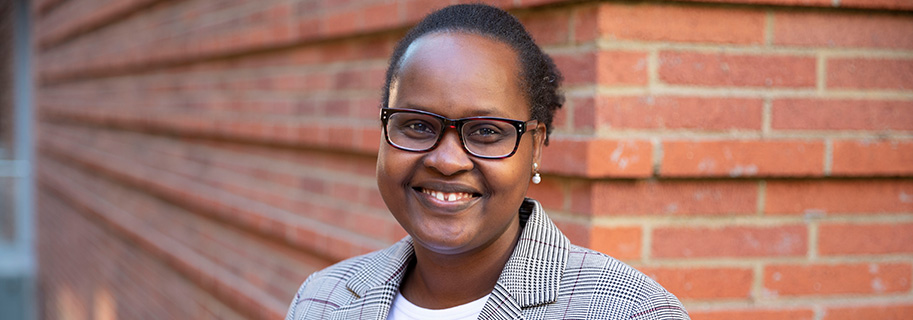
Q&A with Professor Mireille Kamariza
Mireille Kamariza is an assistant professor in the Department of Bioengineering at the UCLA Samueli School of Engineering. She is a chemical biologist with expertise building diagnostics tools against infectious pathogens.
Prior to joining UCLA, Kamariza was a Junior Fellow at the Harvard Society of Fellows working with Prof. Pardis Sabeti at the Broad Institute of Harvard and MIT. During that time, she developed multiplexed high-throughput diagnostic assays against deadly infectious diseases (e.g., Ebola, Lassa Virus, etc.) to support global outbreak surveillance and prevention. In addition, she partnered with the African Centre of Excellence for Genomics of Infectious Diseases (ACEGID) to implement CRISPR-Cas13 diagnostic testing in Ede, Nigeria, which may enable routine surveillance of infectious outbreaks in the region.
Kamariza has received many awards and honors. In 2020, she was named one of Chemical & Engineering News’ Talented 12. During her graduate studies, she received the Ruth L. Kirschstein Pre-Doctoral National Research Service (F31) Award from the National Institutes of Health; Diversifying Academia, Recruiting Excellence Doctoral Fellowship from Stanford University; the Chancellor’s Fellowship and the National Science Foundation F Bridge to the Doctorate Graduate Fellowship at UC Berkeley; and the Maximizing Access to Research Careers Award from the National Institute of General Medical Sciences while at UC San Diego. In 2017, she was selected as one of Fortune magazine’s World’s Most Powerful Women.
The following questions and answers have been edited for clarity and brevity.
“The field of bioengineering is essentially a sector of collaborating engineers, chemists, and biologists. As interdisciplinary work is increasingly in high demand, I think the future is very bright for bioengineers and biomedical engineers!”
Q: What are some of the main research projects that you are focusing on in 2023-2024?
A: I’ve just started at UCLA! This year, I am focused on starting up my laboratory, recruiting students and getting started on exciting projects. We are eager to design some assays that can rapidly detect Mycobacterium tuberculosis drug-resistance, dormancy, as well as some clustered regularly interspaced short palindromic repeats (CRISPR)-based work to detect malaria and other bloodborne microbes. Eventually, we hope to transform these studies into diagnostic technologies as well as tools that we can use to study microbes and engineer potential novel therapeutics.
Q: How do you work with undergraduate and graduate students on these research projects?
A: At this moment, I have weekly meetings with students, either one-on-one, in small sub-teams, or a combination of both. We also hold large group meetings once a week that everyone in my lab is expected to attend.
Q: How do you hope your research will be used in real-world applications in the future? How do you see your research being used in the health sector?
A: My primary research motivation has always been to develop techniques and products that can be easily and readily implemented in the clinics, whether at major hospital systems like UCLA Health, or in low-resource environments like Burundi, my country of birth. Specifically, with my ongoing UCLA research program, I hope to provide a rapid and specific technology that can detect drug-resistant tuberculosis (TB) at the point of care. Millions of patients continue to lose their battle against TB. Sadly, increasing occurrences of drug resistance TB only hinder any progress made. At this time, to accurately diagnose drug-resistant TB in the developing world, patients and doctors still rely on weeks-long processes that can only be performed in high-end laboratory facilities (most often national laboratories). With the new assay we’re developing, we’d cut the time-to-result from weeks to days, and we hope the assay can be performed at the local clinic, which would further speed the results’ turn-around time. We have exciting preliminary data and we’re looking forward to testing our assay in the field!
Q: How could private funding through donor gifts enable you to further your research at UCLA?
A: Private funding is critical to any successful research enterprise. Public funding often restricts the type of questions that can be asked and often does not support ‘seed-level’ unproven ideas. This is precisely where private funding is most needed. Scientists need the flexibility to pursue innovative ideas that may lead to commercial products and private funding can enable academics to do so. My lab specifically aims to design and develop technologies that can be implemented in low-resource environments for the betterment of global health. For us, private funding is critical for our success.
Q: What sparked your interest in bioengineering? In particular chemical biology and infectious disease research?
A: I have always been curious about the world around me. Over time, I became fascinated by the idea of leveraging the advances in chemistry to develop new tools against infectious diseases. In fact, I joined a chemistry lab to work on tuberculosis! This was unusual at the time, but it paid off. I used the tools and principles of chemical biology (which had been used in cancer, diabetes, etc.) and I successfully applied them to tuberculosis diagnostics. For me, focusing on infectious diseases is personal. My country of birth, Burundi, is burdened with high tuberculosis mortality rates and new advances in tuberculosis diagnostics could contribute to a complete eradication of the disease worldwide.
Q: What do you think about the future when it comes to the collaboration between bioengineering with diagnostics, therapeutics and medicine?
A: I believe the world of science is getting more and more interdisciplinary. This was evident at the height of the pandemic crisis. Indeed, chemists, biologists and engineers came together in lightning speed to generate protective equipment, sanitizing reagents, diagnostics, therapeutics and vaccines. Bioengineers sit right at the center of this industry. The field of bioengineering is essentially a sector of collaborating engineers, chemists and biologists. As interdisciplinary work is increasingly in high demand, I think the future is very bright for bioengineers and biomedical engineers!
